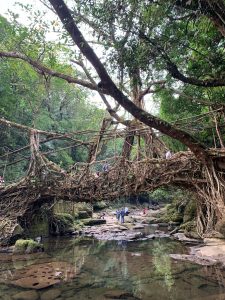Bridging the Human and More-than-human World
A Counterpoint: Navigating Knowledge Research Colloquium

Living root bridges are among the biggest tourist attractions in the Indian state of Meghalaya. The indigenous Khasi and Jaintia communities build these bridges together with the aerial roots of the Ficus elastica tree. They are essential to the daily life of communities. They serve as means of transport to cross rivers in remote areas. In the Jaintia and East Khasi Hills, these structures are formed to cross rivers that swell due to the monsoon. It can take several years for the roots of the tree to grow over a bamboo structure in such a way that the bridge can be walked on. The Indigenous knowledge of how these flexible and original landscape elements are formed is now also of interest to Western scientists.
Increased interest from universities, architects, and tourists has also contributed to more villages dedicating themselves to passing on this tradition and preserving their imposing bridges. From being a pure necessity where there were no other options, these bridges have thus also become a trademark of a certain landscape and culture. The self-reinforcing causes and consequences of climate change, such as deforestation and changes in precipitation patterns, are increasing the importance of these bridges. They stabilize the slope and help prevent landslides. Plants and people appear equally as builders. They are therefore particularly suitable as symbols to celebrate Indigenous knowledge systems and to question how they can challenge and transform Western-dominated historical sciences.
The exhibition “Trees, Time, Architecture,” which is on display in Munich, showcases this and other examples of how plants and humans interact to identify possibilities of building a livable future for us and the greater part of the Earth’s flora and fauna. The exhibition looks back on the long history of mutual influence between trees and humans and various forms of landscape and architectural design. It tells of utopian visions of nature-oriented construction, of practices that work differently, but also of stories of failure, the destruction of landscapes, and the massive killing of trees.
Deforestation, forest degradation, and climate change are the main threats to the living root bridges in Meghalaya. This makes preserving them even more challenging. At the same time, they serve as an important example of an ecological paradigm shift that can be applied to other areas of life: bridges made of steel and concrete usually have an architect, and once built, are designed for long-term use and relatively low maintenance. The living bridges, on the other hand, often have an entire community that uses them intensively and cares for them. They require regular maintenance and careful observation of changes in their structures. This makes them examples of community inclusivity. Interest in such bridges has grown, and there is now a broad alliance of educational institutions, government actors, and private tourism initiatives committed to preserving them.
The example of living bridges can also be applied to our intellectual architectures. The rapidly growing field of ecological humanities investigates the extent to which environmental influences affect the humanities, leading to an increasing intertwining of biology, anthropology, and social sciences rather than a disconnected coexistence. The cosmologies and legends of the Khasi and other peoples contain numerous examples of an animated cosmos in which plants and birds talk to humans and intervene in their fate. These are not stories from the past that have no future today but can be seen as a wealth of experience that invites us to challenge our own worldview.
Ignoring the close connection between humans and biodiversity does not lead to autonomous knowledge and a better life, but instead to a multitude of problems and a deterioration in living conditions. As a result, nonhuman actors are increasingly seen as important elements of historiography, and consideration is being given to the extent to which landscapes also influence human social structures. What sounds unorthodox to the Western scientific tradition is common sense for many non-Western scientists and Indigenous communities. The shared environment is often understood as part of one’s own community, and there are diverse relationships with nonhuman entities. Building bridges together is one of the most striking examples of this.
In recent years, awareness of the climate crisis has led to increased interest in alternative knowledge systems, as evidenced by Counterpoint: Navigating Knowledge. We are witnessing a relational shift toward a deeper understanding of the interdependence of plants, humans, and animals. Artists are increasingly perceiving animals and plants as partners in their creative process. And in anthropology, sociology, and history, we are also seeing a profound paradigm shift toward multi-species approaches. History cannot be told solely as stories about human beings; it becomes truer and closer to the reality of our lives when we include our co-worlding partners. Many Indigenous communities have not had to face this shift in perspective because they have long drawn on knowledge systems that already understand this interconnectedness as central.
A place where these intense interrelationships are striking is in northeastern India and the neighboring countries on the edge of the Himalayas. There is also a rich body of research literature on this community. The Khasi and Jaintia are not the only ones that have a long and tense history of coexistence with the forest and its creatures. Historian Joy Pachuau, together with her colleague Willem van Schendel, has presented a detailed description of the diverse relationships between human and nonhuman actors. She challenges established historical scholarship to break free from the iron prison of human speciesism. She vividly and practically recounts cultures of fermentation that have shaped culture, landscape, and ways of life and are expressions of human and non-human co-creation. The practice of fermentation, which cannot function without the help of numerous bacteria, has fostered a specific diet and way of life. The cultivation and harvesting of special types of vegetables. The brewing of various alcoholic beverages and a rich cultural reservoir of festivals and customs.
In a workshop on 23 May 2025, she will provide insights into the practical aspects of this research.
Indigenous sociologists and anthropologists have taken up this research and are thinking about the interconnectedness of trees, forests, and people from different perspectives and communities. Another panel at this workshop will provide critical reflections on this body of literature. However, epistemic justice that takes such knowledge systems seriously is only one form of justice that Indigenous historians are passionate about. Other important questions relate to the established fields of research known as tribal studies, feminist research, and Dalit research. Accordingly, yet another panel will explore possible connections and bridges to these research traditions.
The event is open to anyone interested in learning more about Indigenous knowledge and human-nature relationships. Participation is free of charge. Further information can be found on the websites of the organizing institutions.
Title of Workshop: Forest, Trees and People. Navigating through More-Than-Human histories in North-East-India
Joint Workshop by Friedrich-Alexander-University Erlangen-Nuremberg, Jahawarlal Nehru University, New Delhi, Sikkim University Gangtok, Universität Zürich and North-Eastern-Hill-University in Shillong. Hosted by Counterpoint: Navigating Knowledge
Date: Friday, 23 May 2025
Website with more information: FAU Friedrich-Alexander-Universität
Image credits: © Thomas Malsom, used with permission.



